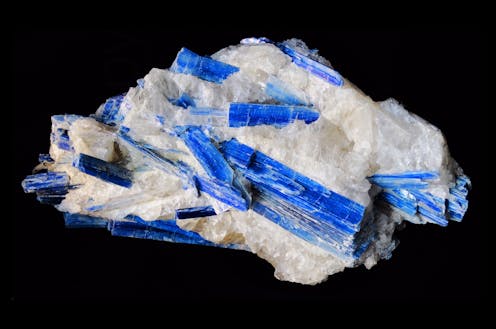How do crystals form?
- Written by Natalie Bursztyn, Lecturer in Geosciences, University of Montana

Why and how crystals form
Crystals grow when molecules that are alike get close to each other and stick together, forming chemical bonds that act like Velcro between atoms. Mineral crystals cannot just start forming spontaneously – they need special conditions and a nucleation site[13] to grow on. A nucleation site can be a rough edge of rock or a speck of dust that a molecule bumps into and sticks to, starting the crystallization chain reaction.
At or near the Earth’s surface, many molecules are dissolved in water that flows through or over the ground. If there are enough molecules in the water that are alike, they will separate from the water as solids – a process called precipitation. If they have a nucleation site, they will stick to it and start to form crystals.
Rock salt, which is actually a mineral called halite[14], grows this way. So does another mineral called travertine[15], which sometimes forms flat ledges in caves and around hot springs, where water causes chemical reactions between the rock and the air.
You can make “salt stalactites[17]” at home by growing salt crystals on a string. In this experiment, the string is the nucleation site. When you dissolve Epsom salts in water and lower a string into it, then leave it for several days, the water will slowly evaporate and leave the Epsom salts behind. As that happens, salt crystals precipitate out of the water and grow crystals on the string.
Many places in the Earth’s crust are hot enough for rocks to melt into magma[18]. As that magma cools down, mineral crystals grow from it, just like water freezing into ice cubes. These mineral crystals form at much higher temperatures than salt or travertine precipitating out of water.
What crystals can tell scientists
Earth scientists can learn a lot from different types of crystals. For example, the presence of certain mineral crystals in rocks can reveal the rocks’ age. This dating method is called geochronology[19] – literally, measuring the age of materials from the Earth.
One of the most valued mineral crystals for geochronologists is zircon[20], which is so durable that it quite literally stands the test of time. The oldest zircons ever found[21] come from Australia and are about 4.3 billion years old – almost as old as our planet itself[22]. Scientists use the chemical changes recorded within zircons as they grew as a reliable “clock” to figure out how old the rocks containing them are[23].
Some crystals, including zircons, have growth rings, like the rings of a tree[24], that form when layers of molecules accumulate as the mineral grows. These rings can tell scientists all kinds of things about the environment in which they grew[25]. For example, changes in pressure, temperature and magma composition can all result in growth rings.
Sometimes mineral crystals grow as high pressure and temperatures within the Earth’s crust change rocks from one type to another in a process called metamorphism[27]. This process causes the elements and chemical bonds in the rock to rearrange themselves into new crystal structures. Lots of spectacular crystals grow in this way, including garnet[28], kyanite[29] and staurolite[30].
Amazing forms
When a mineral precipitates from water or crystallizes from magma, the more space it has to grow, the bigger it can become. There is a cave in Mexico full of giant gypsum crystals[32], some of which are 40 feet (12 meters) long – the size of telephone poles.
Especially showy mineral crystals are also valuable as gemstones for jewelry once they are cut into new shapes and polished. The highest price ever paid for a gemstone was $71.2 million for the CTF Pink Star diamond[33], which went up for auction in 2017 and sold in less than five minutes.
Hello, curious kids! Do you have a question you’d like an expert to answer? Ask an adult to send your question to CuriousKidsUS@theconversation.com[34]. Please tell us your name, age and the city where you live.
And since curiosity has no age limit – adults, let us know what you’re wondering, too. We won’t be able to answer every question, but we will do our best.
References
- ^ Curious Kids (theconversation.com)
- ^ curiouskidsus@theconversation.com (theconversation.com)
- ^ ordered chemical structure (theconversation.com)
- ^ cubes or more complex shapes (australian.museum)
- ^ an Earth scientist and a teacher (scholar.google.com)
- ^ are found naturally in the ground (www.britannica.com)
- ^ their constituent atoms (www.youtube.com)
- ^ All minerals are crystals (www.geologyin.com)
- ^ pyrite, which is known as fool’s gold (theconversation.com)
- ^ bismuth (www.zmescience.com)
- ^ James St. John/Flickr (flic.kr)
- ^ CC BY (creativecommons.org)
- ^ nucleation site (www.thoughtco.com)
- ^ a mineral called halite (www.britannica.com)
- ^ another mineral called travertine (www.britannica.com)
- ^ USGS (d9-wret.s3.us-west-2.amazonaws.com)
- ^ salt stalactites (www.sciencekidsathome.com)
- ^ rocks to melt into magma (www.britannica.com)
- ^ geochronology (www.britannica.com)
- ^ zircon (geology.com)
- ^ oldest zircons ever found (www.si.edu)
- ^ old as our planet itself (www.amnh.org)
- ^ figure out how old the rocks containing them are (knowablemagazine.org)
- ^ rings of a tree (naturalsciences.org)
- ^ the environment in which they grew (theconversation.com)
- ^ CC BY-ND (creativecommons.org)
- ^ metamorphism (www.amnh.org)
- ^ garnet (geology.com)
- ^ kyanite (geology.com)
- ^ staurolite (geology.com)
- ^ Paul Starosta via Getty Images (www.gettyimages.com)
- ^ cave in Mexico full of giant gypsum crystals (cen.acs.org)
- ^ CTF Pink Star diamond (www.npr.org)
- ^ CuriousKidsUS@theconversation.com (theconversation.com)
Authors: Natalie Bursztyn, Lecturer in Geosciences, University of Montana
Read more https://theconversation.com/how-do-crystals-form-213202

